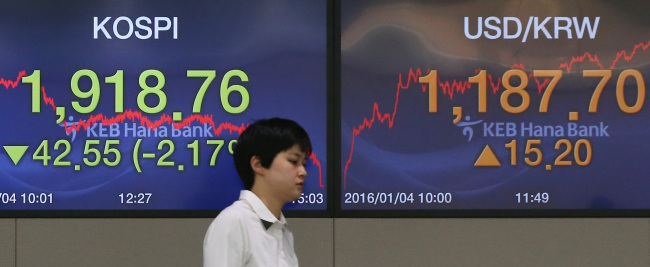
After moving directionless for much of 2015, Korea’s main stock market is expected to trade sideways again in 2016, but with increased volatility, local analysts predict.
Their forecasts have the benchmark index KOSPI moving in a range of some 300 to 400 points, roughly between 1,800 and 2,200, as several external factors and weak earnings outlooks weigh down on local shares.
“The KOSPI in 2016 is unlikely to break out of a recurring pattern described locally as ‘boxpi,’” said Kim Hak-kyun, a strategist at KBD Daewoo Securities. Boxpi, coined from the combination of box and KOSPI, describes the gauge’s movements since 2011 that appear to be trapped in a box.
After a relatively bullish first few months, local shares slid in the latter half of 2015 to close at 1961.31 points on the last trading day of 2015, which was 2.33 percent higher than the year before. KDB Daewoo summarized 2015 with the phrase “much ado about nothing,” indicating that it was a rough ride to nowhere.
In the first trading session of 2016 on Monday, the index plunged 2.17 percent to end at 1,918.76, jolted by China’s stock market crash.
Although there seems to be a consensus that 2016 will be another “boxpi” year, stock market predictions vary widely when it comes to details. Lows in major brokerage houses’ 2016 KOSPI target band range from 1,700 to 1,900 while the highest of the high points is 2,300.
A typical way to predict the local stock market over the past several years has been to compare the projected stock price levels of the first half and the second half of the year, but even that seems to be a daunting task.
KDB Daewoo has the gloomiest forecast, pegging the low point of its KOSPI target range at 1,700 and the high at 2,150.
“In an environment where supply exceeds demand, suppliers must downsize. Such corporate restructurings could cause short-term shocks (on the stock market), pulling the KOSPI’s bottom line to below the 2015 level,” Kim explained.
Shinhan Investment’s outlook is the rosiest, with a low of 1,900 and a high of 2,350.
Samsung Securities, while predicting the KOSPI to move between 1,880 and 2,240, noted the likelihood of its own prediction missing the mark and called for risk management.
“We release a KOSPI target range and portfolio strategy based on what is predictable, but we put more weight on the likelihood that the KOSPI breaks past that range,” it said in a research paper.
In a monetary easing cycle, liquidity drives stock market rallies. In a tightening cycle, corporate earnings are the key factor that could prop up stock prices, Samsung Securities explained. “But Korea’s earnings momentum is weak, as major companies are export-oriented and the global trade outlook remains cloudy.”
The U.S. delivered its first interest rate hike in nine years in December and is expected to further increase the borrowing costs throughout 2016. Higher interest rates in the U.S. are feared to prompt capital outflow from Korea. According to Korea Exchange, foreign investors sold local shares worth 3.5 trillion won in 2015.
Along with the U.S. rates, the November presidential elections in the U.S. are a key external factor to watch out for their potential impact on the local stock market, analysts said. Big swings in oil prices and China’s economic cooling are also likely to have impacts on stock prices here.
Korean exporters, many of them large caps on the local bourse, have underperformed in the past few years as their earnings dropped in the face of a prolonged slump in global demand. As the large caps continued to disappoint, investors favored growth stocks ― small and medium companies with high growth potentials.
This year, some experts foresee a shift toward value stocks, as growth stocks run out of room for further rise and the overall stock market is expected to see heightened volatility stemming from external factors, including the U.S. and Chinese economic conditions and oil prices.
“Starting from this year, some of the large-cap stocks could turn more appealing, viewed as value stocks. This year, we predict a shift toward value and the return of large caps,” said Ahn Hyuk of Korea Investment & Securities Co.
By Lee Sun-young (milaya@heraldcorp.com)
-
Articles by Korea Herald


![[Exclusive] Korean military set to ban iPhones over 'security' concerns](http://res.heraldm.com/phpwas/restmb_idxmake.php?idx=644&simg=/content/image/2024/04/23/20240423050599_0.jpg&u=20240423183955)




![[Herald Interview] 'Amid aging population, Korea to invite more young professionals from overseas'](http://res.heraldm.com/phpwas/restmb_idxmake.php?idx=644&simg=/content/image/2024/04/24/20240424050844_0.jpg&u=20240424200058)
![[Pressure points] Leggings in public: Fashion statement or social faux pas?](http://res.heraldm.com/phpwas/restmb_idxmake.php?idx=644&simg=/content/image/2024/04/23/20240423050669_0.jpg&u=)










